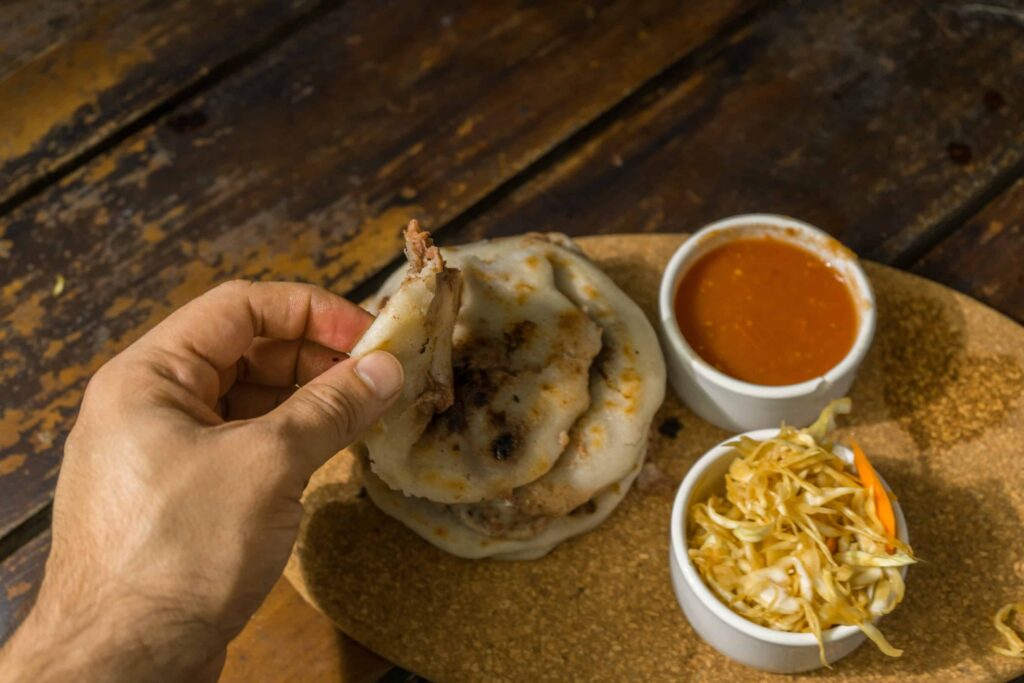
El Salvador‘s national dish has made its way into the hearts (and bellies) of many around the world: the pupusa. A simple yet flavorful dish, it is a cornerstone of Salvadoran cuisine and has established itself firmly in the culinary landscapes of many other countries, especially in the US.
Learn more about the pupusa, plus get a recipe you can try at home. Remitly is proud to present this guide as part of our series on the traditional foods of our global customers.
Pupusa History
The roots of the pupusa stretch back over two thousand years to the Pipil tribes of El Salvador. These delicious tortillas, filled with various ingredients, were already popular long before the arrival of the Spanish conquistadors. Their rich history is woven into the very fabric of Salvadorian culture and society.
Pupusa Meaning
Derived from the Pipil word “pupusawa”, a pupusa is essentially a stuffed tortilla made of corn flour, primarily masa harina or maseca. It’s more than just a dish; it’s a symbol of unity and heritage for Salvadorans.
How to Make Pupusas at Home
Making pupusas is an intimate experience, often passed down through generations. Here’s a basic pupusa recipe:
Ingredients:
- 2 cups masa harina (cornmeal)
- 1 cup water
- Fillings: refried beans, shredded mozzarella, chicharrón, or zucchini
- Kosher salt
Procedure:
- In a large bowl, mix the masa harina with warm water and a pinch of salt. Knead until you get a soft masa dough that’s similar to playdough.
- Roll the dough into golf ball-sized dough balls.
- Make a well in the center of each ball and fill with your chosen ingredients. Seal the ball, then flatten into a disc.
- Heat a cast iron griddle or pan over medium heat. With a touch of vegetable oil, cook pupusas for about 4 minutes each side, or until golden and crispy.
How to Make Curtido
Curtido, a tangy cabbage slaw with jalapeño and oregano, is the traditional accompaniment to pupusas.
Ingredients:
- Cabbage, shredded
- 1 Jalapeño, sliced
- Carrots, grated
- 1 teaspoon salt
- Oregano
- Warm water
- Apple cider vinegar
Procedure:
- In a medium bowl, combine cabbage, jalapeños, and carrots.
- Sprinkle with salt, oregano, and then cover with warm water and a splash of vinegar.
- Let it sit for a few hours until it becomes a pickled cabbage.
Pupusa and Curtido: The Perfect Combo
The creaminess of queso (cheese) or the rich taste of refried beans in the pupusas contrasts beautifully with the tangy bite of curtido. This dynamic duo represents the best of Salvadorian flavors.
Variations in El Salvador and the US
While traditional fillings like chicharrón and cheese remain popular, the US has seen innovative fillings like zucchini and black beans. Some even blend Salvadorian and Mexican cuisines, combining ingredients common in tacos or tamales.
Famous Pupusa Restaurants
From street vendors in El Salvador to renowned establishments in major US cities, pupusas have taken center stage. In LA, ‘Pupuseria La Bendición’ and in San Francisco, ‘Balompié Cafe’, are must-visit spots for first-time pupusa enthusiasts.
More Popular El Salvadoran Foods
Beyond pupusas, El Salvador offers a variety of delectable dishes and sides that you will want to try when you visit the country. Here are some other Salvadoran dishes and sides to explore:
- Tamales: Steamed corn dough, filled with meats or beans, wrapped in banana leaves.
- Salsa Roja: A savory tomato-based sauce with spices, perfect for dipping or drizzling.
- Yuca Frita: Fried cassava root, often served with chicharrón.
- Platanos Fritos: Fried sweet plantains, a common side dish.
- Gallo en Chicha: Chicken cooked in a fermented corn drink.
- Sopa de Pata: A flavorful soup made with cow’s feet.
- Ensalada: A refreshing drink made from pineapple, apple, and other fruits.
The pupusa is more than just a meal; it’s an experience. It is a part of all Salvadorean celebrations, but also of everyday life. So, next time you’re at a grocery store searching for gluten-free alternatives or simply wish to try something new, grab some corn masa and give pupusas a go.
Visit the homepage, download our app, or check out our Help Center to get started.